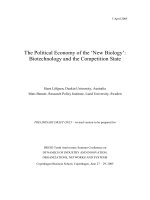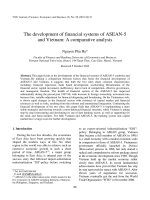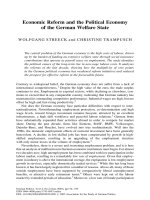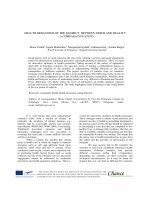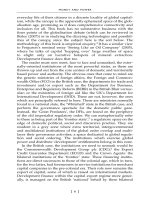Tanzania and Vietnam A Comparative Political Economy of Economic Transition
Bạn đang xem bản rút gọn của tài liệu. Xem và tải ngay bản đầy đủ của tài liệu tại đây (2.16 MB, 340 trang )
Gray,HazelSophia(2012)TanzaniaandVietnam:AComparativePoliticalEconomyOfeconomic
Transition.PhDThesis,SOAS(SchoolofOrientalandAfricanStudies)
/>
Copyright©andMoralRightsforthisthesisareretainedbytheauthorand/orother
copyrightowners.Acopycanbedownloadedforpersonalnon‐commercialresearchor
study,withoutpriorpermissionorcharge.Thisthesiscannotbereproducedorquoted
extensivelyfromwithoutfirstobtainingpermissioninwritingfromthecopyrightholder/s.
Thecontentmustnotbechangedinanywayorsoldcommerciallyinanyformatormedium
withouttheformalpermissionofthecopyrightholders.
Whenreferringtothisthesis,fullbibliographicdetailsincludingtheauthor,title,awarding
institutionanddateofthethesismustbegivene.g.AUTHOR(yearofsubmission)"F
ull
thesistitle",nameoftheSchoolorDepartment,PhDThesis,pagination.
Tanzania and Vietnam:
A Comparative Political Economy
of Economic Transition
Hazel Sophia Gray
Thesis submitted for the degree of PhD in Economics
2012
Department of Economics
School of Oriental and African Studies
University of London
2
Declaration for PhD thesis
I have read and understood regulation 17.9 of the Regulations for students of the School
of Oriental and African Studies concerning plagiarism. I undertake that all the material
presented for examination is my own work and has not been written for me, in whole or
in part, by any other person. I also undertake that any quotation or paraphrase from the
published or unpublished work of another person has been duly acknowledged in the
work which I present for examination.
Signed: ____________________________ Date: _________________
3
Abstract
This thesis explores the process of economic transition in two contemporary developing
countries from a political economy perspective. Tanzania and Vietnam were at the
forefront of the struggle to construct socialism in the twentieth century. Since the 1990s
Tanzania and Vietnam have been championed by international development institutions
as success stories of market liberalization, achieving growth rates above their regional
averages. Yet both economies have also been associated with high levels of corruption
under the continued control of the pre-reform ruling party. The pattern of economic
growth cannot be adequately explained by New Institutional Economics. Instead, the
thesis uses a Political Settlements framework for analysis. Features of the formative
socialist political settlement were critical for the evolution of the political settlement
under liberalisation. The thesis explores how the political settlement influenced processes
of political redistribution, primitive accumulation and technology acquisition under
liberalisation. These processes are examined through case studies of reform in public
finance, land management and industrial policy. Tanzania and Vietnam both have
cohesive party states based on consolidated political power within the party institutions.
The distribution of power within the party and society and the relationship between
political and economic power were critical determinants of economic transition. While
each of these states were able to direct some resources centrally to new economic
activities, informal processes outside the central political institutions played a more
important role in determining the path of the key transition processes. Both countries
largely failed to manage rents that could generate greater productivity growth. Further,
the focus on market liberalisation and roll back of the state did not strengthened state
capacities in these critical areas. This does not auger well for the longer term path of
economic development in Tanzania and Vietnam.
4
Acknowledgements
Invaluable assistance from a number of individuals and organisations made this research
possible. I would like to express my gratitude to my supervisor Professor Mushtaq Khan
who has been an excellent mentor, generous teacher and friend over the course of
researching and writing this thesis.
I was very fortunate to be awarded a SOAS Research Student Fellowship Bursary for
which I would like to thank SOAS. I would also like to thank the University of London
Central Research Fund for a grant to cover research trips to Tanzania in 2005 and
Vietnam in 2006. Many people in Tanzania and Vietnam contributed in various ways to
the completion of this PhD. I would particularly like to thank Chau Me and Vo Duy Anh
for excellent translation assistance and To Van Nhat, Nguyen Dinh Tho and Jonathan
Pincus for help in organising a research visit to Vietnam in 2006. I would like to thank
my colleagues at the Ministry of Finance in Tanzania from 2000 to 2003. I would like to
thank my sister-in-law Nuru Madati for generous hospitality during various research trips
to Tanzania. I would like to express my gratitude to Stephanie Blankenburg for
comments on the chapters and wise guidance over the years. I am very grateful to my
father, Patrick Gray, for corrections to the full draft in the final stages and for sharing his
knowledge of economic development in Russia. I would like to thank Chirashree Das
Gupta, Tim Kelsall and Jonathan Pincus for taking the time to read and comment on
various chapters of the PhD. I would like to thank Lindsay Whitfield for inviting me to
participate in a seminar at the Danish Institute for International Studies in May 2011
where I presented some of the findings of the PhD and received useful feedback from
the audience. Errors in the PhD are mine alone.
Without the support of my parents, Patrick and Winifred Gray, finishing the PhD would
have been impossible. My sisters Rosalind Gray and Elizabeth Rumler also gave me
unfailing encouragement over the years. My children Adili, born in 2008, and Hugo, born
in 2010, have provided joyful distraction from the PhD.
I dedicate this PhD to my husband, Amani Kagungila, with heartfelt thanks for the
advice, companionship, support and love he has given me at each step along the way.
5
Table of Contents
Declaration 2
Abstract 3
Acknowledgements 4
Table Contents 5
List of Tables 8
Map of Tanzania 11
Map of Vietnam 12
Chapter 1: The Problematic 13
1.1 Introduction 13
1.2 Justifications for a Comparison of Tanzania and Vietnam 16
1.2.1 Constructing Socialism 16
1.2.2 Economic Growth Under Liberalisation 20
1.2.3 Political Institutions Under Liberalisation 39
1.3 Main Findings of the PhD 47
Chapter 2: The Analytical Framework 51
2.1 Introduction 51
2.2 New Institutional Economics 51
2.3 Heterodox Theories of the Role of the State 66
2.4 Political Settlements 71
2.4.1 Drivers of Economic Transition 75
2.4.2 The Formative Socialist Political Settlement 80
2.5 Conclusion 85
Chapter 3: The Political Settlement in Tanzania and Vietnam 87
3.1 Introduction 87
3.2 The Political Settlement Under Colonialism 87
6
3.2.1 Tanzania 87
3.2.2 Vietnam 93
3.2.3 Discussion 99
3.3 The Impact of Independence Struggles on the Political Settlement 101
3.3.1 Tanzania 101
3.3.2 Vietnam 104
3.3.3 Discussion 108
3.4 Constructing the Formative Socialist Political Settlement 110
3.4.1 Tanzania 110
3.4.2 Vietnam 115
3.4.3 Discussion 118
3.5 Conclusions 123
Chapter 4: Public Finance 125
4.1 Introduction 125
4.2 Tanzania 128
4.2.1 Public Finance Reforms 130
4.2.2 Impact of Reforms on Aid Flows 133
4.2.3 Ring Fencing of Tax Incentives for FDI 134
4.2.4 Public Finance and the Mining Sector 137
4.2.5 Grand Corruption and Public Finance 142
4.3 Vietnam 149
4.3.1 Outcome of Public Finance Reforms 152
4.3.2 Corruption Associated with On-budget Capital Expenditures 156
4.3.3 Off-budget Funds and the Relationship between SOEs and VCP 159
4.3.4 The Banking Sector 164
4.4 Discussion 168
Chapter 5: Land 178
5.1 Introduction 178
5.2 Vietnam 181
5.2.1 Historical Overview of Land Management 181
7
5.2.2 Land Reform Process Since Doi Moi 183
5.2.3 Corruption and Primitive Accumulation 186
5.2.4 Rural Land Transition 188
5.2.5 Industrial Zones 191
5.3 Tanzania 198
5.3.1 Historical Overview of Land Management 198
5.3.2 The Reform of the Land Laws 201
5.3.3 Title Recognition and Registration 202
5.3.4 Buying and Selling Land 204
5.3.5 Corruption and Primitive Accumulation 206
5.3.6 Land for Mining 208
5.3.7 Land for Agriculture 211
5.3.8 Urban Land, Manufacturing and Tourism 216
5.4 Discussion 219
Chapter 6: Industrial Policy 225
6.1 Introduction 225
6.2 Socialist Industrial Policy 228
6.2.1 Tanzania 228
6.2.2 Vietnam 235
6.2.3 Discussion 238
6.3 Industrial Policy Reforms 240
6.3.1 Industrial Policy Reforms and Privatisation in Tanzania 240
6.3.2 Industrial Policy Reforms and Equitisation in Vietnam 246
6.3.3 Discussion 250
6.4 Industrial Policy under Liberalisation 251
6.4.1 Tanzania 251
6.4.2 Vietnam 259
6.4.3 Discussion 267
Chapter 7: Conclusions 270
Bibliography 292
Annex One: Tables and Data 338
8
List of Tables
Table
Title
Page
1.1
Comparison of National and Sectoral Average Growth 1986 –
1995
24
1.2
Comparison of National and Sectoral Average Growth 1996 –
2005
24
1.3
Percentage Share of Total Employment in Major Sectors in
Tanzania and Vietnam 2001, 2006
25
1.4
Agricultural Output Growth Vietnam - Selected Crops (million
tons)
26
1.5
Vietnamese export composition: 1995 – 2002 (percentages)
27
1.6
Growth across sectors in Tanzania
28
1.7
Production of Selected Manufactured Commodities 1990 – 2003
29
1.8
Contribution of the Mining Sector to the Economy
30
1.9
Value Added Per Worker in Manufacturing in Selected Asian
Countries (USD)
37
1.10
Comparison of the Institutions of the Party under Liberalisation
45
2.1
WGI for Tanzania and Vietnam over the Period of Liberalisation
55
2.2
Comparison of different approaches to the role of institutions in
economic performance in developing countries
86
3.1
Summary of Political Institutions and Distribution of Power under
Colonialism
100
3.2
Summary of Political Institutions and Distribution of Power under
Socialist Political Settlement
121
4.1
Tanzania Revenue as a % of GDP
132
4.2
Composition of Government Revenues 1996 - 2008
133
4.3
Aid as a % of GDP 1986 – 2008 in Tanzania
134
4.4
Distribution of Exemptions (% total of exemptions)
136
4.5
Changes in the Fiscal Framework for Minerals
137
4.6
Taxes paid by mining companies (Million shillings)
150
4.7
Vietnam Composition of Government Revenues 1998 - 2002
155
4.8
Relative Size of Financial Institutions
166
4.9
ICORs in Selected Asian Countries
175
9
5.1
Land Tenure Type
196
5.2
Disputes submitted to the Presidential Ad-hoc Committees, May-
2006
208
6.1
Fixed Capital Formation by the Public and Private Sectors 1961 –
1998
230
6.2
Types of investors in privatized manufacturing firms
244
6.3
Partial and Internal Equitizations
248
6.4
Usefulness of existing export promotion programs
256
6.5
Top 5 Countries Committing Foreign Direct Investment to
Vietnam, 1988 – 1999
259
6.6
Regional and Provincial Distribution of FDI Projects 1988 - 2006
261
A.1
Vietnam Exports of Goods and Services as a % of GDP 1986 -
2005
338
A.2
Savings as a % of GDP in Tanzania 1990 - 2010
338
A.3
Investment as a % of GDP 1968 – 1986
339
10
List of Figures
Fig.
Title
Page
A.
Map of Tanzania
11
B.
Map of Vietnam
12
1.1
Vietnam GDP Per Capita 1947 – 2005
23
1.2
Tanzania GDP Per Capita 1961 – 2005
23
1.3
Comparative GDP Growth Since Liberalization
25
1.4
Vietnam Export of Goods and Services as a % of GDP 1986 -
2005
27
1.5
FDI Flows to Tanzania 1985 – 2005
31
1.6
FDI Flows to Vietnam 1985 – 2005
31
1.7
Savings as a % of GDP 1990 - 2010
33
1.8
Total Investment as a % of GDP in Tanzania and Vietnam 1986
- 2005
33
1.9
Growth of Value Added in Manufacturing as a % of GDP in
Tanzania and Vietnam 1990 - 2010
34
1.10
Comparison of Productivity Growth in Manufacturing in
Vietnam and Tanzania
35
1.11
Comparison of Growth in Labour Productivity During
Transitions
37
1.12
Comparison of Labour Productivity Growth in China and
Vietnam
38
2.1
Relationship between Governance and Growth in Developing
and Advanced Countries
62
6.1
Incentives Offered to Manufacturers in EPZ/SEZs in Tanzania
254
11
A. Map of Tanzania
Source:
12
B. Map of Vietnam
Source:
13
Chapter One
The Problematic
1. Introduction
Over the last two decades of the twentieth century, attempts by some of the poorest
nations in the world to construct socialism were swept away in the wake of the collapse
of the Soviet Union and the ascendancy of neo-liberalism. With the retreat from
socialism, the ensuing restructuring of economic systems on the basis of ‘market
principles’ led to the resurgence of a capitalist dynamic of social and economic
transformation that has taken diverse forms in ex-socialist countries. This thesis
examines the comparative process of economic transition in two of these countries,
Tanzania and Vietnam, from a political economy perspective.
Tanzania and Vietnam were at the forefront of the struggle to construct socialism in the
second half of the twentieth century. The ruling parties, the Vietnamese Communist
Party (VCP) and the Tanganyika National Union (TANU), which emerged from the anti-
colonial struggle established political systems based on one-party rule. This involved
subsuming all state institutions into the party and banning other forms of political and
civil organisations. While these countries, and their approaches to constructing socialism,
differed in many ways, they shared key institutional and socioeconomic characteristics.
As two of the poorest countries in the world, the improvements in human welfare
indicators such as health and education under socialism were remarkable. For a short
period, they also achieved impressive rates of growth and industrialization. By the end of
the 1970s, however, they were facing severe economic crises and the failure to establish
viable socialism was becoming increasingly apparent. In the 1980s, both countries
effectively abandoned the attempt to construct socialism and adopted liberal economic
and governance reform programmes. Yet the political economy of the socialist period
had important implications for the subsequent trajectory of economic growth under
liberalisation.
14
Both countries were championed by international development institutions as success
stories of economic liberalization. Following extensive market reforms, they achieved
growth rates above the average for their respective regions. While the Tanzanian
economy grew well relative to other African countries, Vietnam outperformed Tanzania
in terms of both the rate of economic growth and of structural transformation. In fact,
during the 1990s Vietnam became on of the fastest growing developing countries in the
world (World Bank 2005). In both countries, economic transition under liberalisation
involved removing state created rents of the socialist period and strengthening market
mechanisms. Aid and foreign direct investment flowed into their economies and they
experienced output expansion and export growth across all sectors.
Tanzania experienced a rapid growth in mining as well as in manufacturing, but a more
limited expansion in agriculture. Vietnam had very high growth in agricultural and
industrial output. Industry expanded with rising exports of oil and gas and very rapid
increases in the production and export of manufactured goods. While the increased flow
of capital and new businesses increased overall economic productivity, state led industrial
policies relating to technology acquisition and learning were not very successful. While
manufacturing expanded in both countries, it remained near the bottom end of the
productivity ladder.
Economic liberalisation was accompanied by changes to the political system and in the
constitutional arrangements that placed the party as the overarching institution of the
state. Nevertheless, Vietnam remained legally constituted as a one party state. Tanzania
formally adopted a multi-party system but actually retained the overwhelming political
dominance of the pre-reform socialist party. The on-going strength of the ruling parties
appeared to give the state a higher degree of centralised cohesion than in many other
developing countries. However, both political systems also involved extensive clientelism
and high levels of corruption.
In recent years, one of the most influential frameworks for understanding growth
transitions, both in terms of theory and policy, has been provided by New Institutional
Economics (NIE). NIE, and the associated ‘good governance’ agenda, advocates
property rights stability, reducing corruption, a transparent and accountable public
sector, democratic government, rule of law and competitive (rent free) markets, as a
15
means to promote growth. Through the ‘good governance’ agenda, these
recommendations have become central to reform programmes in developing countries,
sponsored by the international financial institutions. Yet, the experience of economic
transition in Tanzania and Vietnam under liberalisation, where higher rates of growth
were coupled with ‘poor’ governance across a range of different criteria, adds to the
growing evidence that the relationship between institutions and economic outcomes is
complex and this cannot be explained within the NIE framework.
Instead, we use the Political Settlements framework developed by Mushtaq Khan. A
political settlement defines the combination of institutions and the underlying
distribution of power in a society. The distribution of power in society affects the ability
of historically constituted social groups to acquire or hold on to property rights that
generate income or affect resource flows. A picture of the distribution of power in any
society is not just a description of its political institutions but needs to be constructed
from a reading of social and economic history, looking at the past outcomes of social
conflict and the organisation of production. Differences in political settlements have
important implications for the trajectory of economic transition in developing countries.
In Tanzania and Vietnam, the formative socialist political settlement had significant
legacies and unintended consequences for the evolution of the political settlement under
liberalisation. We explore how the political settlement influenced three critical processes
of political redistribution, primitive accumulation (the process of accumulation outside
the formal market process where political power is used to privilege the accumulation
activities of particular individuals), and technology acquisition under liberalisation. These
processes are examined through case studies of reform in public finance, land
management and industrial policy.
This Chapter sets out three areas of commonality between Tanzania and Vietnam that
provide a basis for insightful comparison through which to investigate economic
transition. These are first, the experience of attempting to construct socialism, second,
the relatively successful economic performance under liberalisation, and third, their
system of governance under liberalisation that involved the on-going dominance of the
pre-reform political Party, combined with high levels of corruption and patron-client
relations. The Chapter ends with an outline of the major findings of the PhD. Chapter
Two, on the Analytical Framework, provides a discussion of three different approaches
16
to explaining the role of institutions in economic performance in developing countries:
New Institutional Economics, Heterodox Theories of the State and Political Settlements
Analysis. Each is assessed in terms of its suitability for the objective of the thesis.
Chapter Two also defines the main analytical features of the concept of the formative
socialist political settlement. Chapter Three provides an overview of the evolving political
settlement in Tanzania and Vietnam and explores the comparative features of the
formative socialist political settlement in each country. Chapters Four, Five and Six
present the main research findings of the PhD based on three case studies. Chapter Four
examines public finance reform, Chapter Five examines land management and Chapter
Six examines industrial policy. To conclude, Chapter Seven draws together the main
arguments and evidence on the political economy of economic transition in Tanzania
and Vietnam.
1.2 Justifications for a Comparative Political Economy of Tanzania and Vietnam
1.2.1 Constructing Socialism
Tanzania and Vietnam gained political independence against the historical backdrop of a
world divided along Cold War lines between capitalist, socialist and non-aligned
countries. The socialist experience in both countries was informed by the international
political and ideological framework of that time. Tanzania and Vietnam, therefore, shared
many common political features with a wider group of poor countries that became
independent nations during the same period. There were also important differences
between the socialist systems in Tanzania and Vietnam in terms of how the socialist
parties came to power and in the particular forms of socialist ideology that they
espoused. Nevertheless, they had significant similarities in terms of the institutional
structure of the parties, the distribution of political and economic power between
different social groups, the role of economic planning, and in policies towards
agricultural collectivization and state led industrialisation.
The Tanganyika National Union (TANU) came to power after a relatively short and
largely peaceful anti-colonial struggle that swept it into office in 1961 in the first free
elections. It was not until 1967, following President Nyerere’s Arusha Declaration, that
17
Tanzania adopted a radical socialist transition programme. The Declaration committed
the country to a programme of state-led accumulation in industry, land reform and
‘villagization’ in agriculture, limits on the emergence of capitalist forms of production
and restrictions on private sector accumulation. TANU became Chama Cha Mapinduzi
(CCM), the Party of the Revolution, in 1976 after merging with the Afro-Shirazi Party
that had led the independence struggle on Zanzibar. In the years following the Arusha
Declaration, Tanzania was ‘frequently listed along side Cuba, North Korea and North
Vietnam as one of the few socialist countries in the underdeveloped world’ (Coulson,
1984; 176).
In reality, Tanzania’s socialism was quite eclectic and pragmatic. Tanzania maintained a
non-aligned foreign policy through the cold war period (Pratt 1976). Julius Nyerere’s
philosophy of African socialism, ‘Ujamaa’, was influenced by his idealized vision of
traditional African village life based on equality and reciprocity. It was also influenced by
British Fabianism and the more orthodox socialist ideology of Lenin and Mao and the
economic policies of the USSR. Nyerere was a very charismatic figure within the Party
and Tanzania’s non-aligned socialism attracted a huge amount of attention from within
left wing academia in the 1970s (see for example, Saul 1974) as well from Africans
involved in anti-colonial struggles on the continent.
In the 1970s, on the other side of the globe, Vietnam was coming to the end of its
protracted and bitter struggle for independence. The VCP, founded in 1930 by Ho Chi
Minh and a small group of intellectuals, came to power in 1945 and ruled in the North
from 1954 until the withdrawal of US forces from Saigon and the final unification of the
country in 1976. Victory in the face of the vastly superior military and economic power
of the US was hailed as a triumph of anti-imperial resistance, and in the West, the peace
activism generated by the war was a defining feature of the decade. The route of the VCP
to power was, therefore, very different from that experienced by the CCM in Tanzania.
Further, unlike Tanzania, Vietnam adopted a more orthodox socialism along Marxist-
Leninist lines. In 1978 Vietnam became a member of the Council for Mutual Economic
Assistance (CMEA) and was part of the cold war Soviet bloc.
Despite these differences, the ruling socialist parties shared a number of common
institutional features. The historical parallels of a ruling party that was initially forged by
18
an elite group of intellectuals and developed into mass parties in the course of struggle
against colonial rule were, in fact, common to many other ex-colonial countries (Alavi
1982). TANU and the VCP, however, were more explicitly based on a Leninist model of
the vanguard party that represented the collective interests of the workers and peasants.
Both parties adopted the principles of Leninist democratic centralism where members of
the party were officially free to debate policy internally but once a majority vote had
determined policy, all were supposed to adhere to that position. Both countries banned
other forms of political and civil organisation and officially became one-party states.
Tanzania started off at independence as a multi-party democracy but in 1963 Nyerere
announced that Tanzania would be a one-party state under TANU. After 1945 Vietnam
was also initially ruled by a coalition of parties but from 1951 there was a process of
consolidation of power by the VCP.
In Tanzania, the National Assembly was constitutionally subordinate to the governing
party. The most important policy decision making institutions were CCM sub-groups and
the Cabinet, and more specifically the President himself. Similarly in Vietnam, the
Political Bureau, Secretariat, Central Committee and a series of specialised committees
held formal power at the centre. At the highest level of the Party apparatus, forming the
executive committee of the Central Committee, were the General Secretary and the
Political Bureau. This executive committee was supposed to constitute the most
powerful political group in the country (Beresford and Phong 1998). Both countries,
therefore, had the appearance of a high degree of political centralization through the one-
party system. Further, both parties were extensively institutionalized throughout society
with party cells at village level and associational groups contained within the party
structure.
Tanzania and Vietnam adopted similar economic policies to bring about a socialist
transformation. In both societies under colonialism, economic power had been held
primarily by non-indigenous groups. Both aspired to bring about a fundamental
transition in the distribution of power in society through socialism away from foreign
and domestic capitalists and towards workers and peasants. Their economic policies
involved a centrally planned economic system and administrated prices for most goods.
Central planning is not synonymous with socialism (or vice versa) and aspects of central
planning were used across a range of different countries with non-socialist political
19
systems during the same period (Ellman 1979). Yet the centrally planned economic
system in Tanzania and Vietnam was never as extensive as in other more industrialised
socialist countries in Eastern Europe or in the Soviet Union. Socialist economic policy
also involved extensive state ownership of industry and the nationalisation of foreign and
domestic companies. Peasant agriculture was to be transformed through land reform and
collectivisation.
The formative socialist political settlement became increasingly fragile as the 1970s
progressed for domestic and international reasons. By the end of the 1970s, Tanzania
and Vietnam were facing debilitating shortages and attempts to increase productivity in
industry and agriculture appeared to be failing. The Vietnamese economy, already
strained from war, was again overstretched by the challenge to integrate the South into
the northern centrally planned economic system. The South, however, had become
significantly market oriented under the Republic of Vietnam and the influence of US aid.
This strain was compounded by falling support from the Soviet Union, war in Cambodia,
decline in agricultural and industrial output, as well as by the growth in illegal trade
outside the centrally planned system (Beresford 1988).
In response to the economic crisis, Vietnam adopted a cautious ‘step by step’ approach
to reform (Van Arkadie and Mallon 2003). This started with tentative price and trade
reform from 1979, but policy oscillated between attempts to strengthen the existing
system and efforts to introduce reforms. Deepening economic instability and shortages
led to renewed commitment to market oriented reform and a change in economic
objectives with the adoption of Doi Moi (Renovation) at the Sixth Party Congress in
1986. The official timing of the Doi Moi announcement was also linked to a shift in
political power within the Party from the ‘old guard’ to a group of younger leaders. Le
Duan, who had been Secretary-General of the Party since 1960, died and Nguyen Van
Linh was elected to the position in December 1986 at the Party Conference. At the same
time, Do Muoi was elected as Prime Minister, replacing Pham Van Dong. The aim of
transition to socialism within the subsequent five year plan was shelved and in its place
the market and later, the private sector, were given an increasingly prominent role.
Tanzania’s reforms also started tentatively in the early 1980s following a mounting crisis
and fiscal deficit exacerbated by the war against Iddi Amin in Uganda, successive severe
20
droughts, mounting debt burden and declining aid. Internally, industrial output and
official exports were falling, the administrative pricing system was in disarray and there
was a burgeoning parallel economy. Income per capita fell by an average of 1.5% a year
for the first five years of the 1980s (Bigsten and Danielsen 2001). President Nyerere
stepped down in 1985 and subsequently the new President, Ali Hassan Mwyini, signed a
standby agreement with the IMF and a Structural Adjustment Package with the World
Bank.
The common institutional and political features of their socialist experiences provide an
interesting point of comparison between the two countries. The details of the
comparative evolution of the formative socialist political settlement and its eventual
demise are further discussed in Chapter Three.
1.2.2 Economic Growth Under Liberalisation
The second area of commonality involves the two countries experience of economic
growth following liberalization. The comparative context of the policy reforms is
discussed by Van Arkadie and Dinh (2005). They argue that Tanzania adopted a much
more orthodox market reform programme while Vietnam maintained key elements of
the centrally planned economy, most notably, an important role for state ownership.
Many of the features of Vietnam’s reform programme were in line with orthodox market
reform. They included price and trade liberalization, macroeconomic stabilization and a
revaluation of the exchange rate, liberalization of foreign investment, recognition of
private land use rights and reduction in state controls on the private sector, particularly
after the introduction of the Enterprise Law in 2000.
Other features of the reform programme were more unorthodox. Certain elements were
very different from the ‘shock’ reform programmes in Russia and Eastern Europe and
the conventional structural adjustment packages for developing countries of the Bretton
Woods institutions. Vietnam focused on consolidating the State Owned Enterprise
(SOE) sector, rather than opting for extensive privatization. The share of the state sector
in the economy initially expanded before more extensive equitization was initiated after
2000 and account for around 39% of GDP by the mid 2000s (Sjoholm 2006)
21
In comparison, Tanzania’s liberalization programme had all the elements of a
conventional structural adjustment package. The liberalization programme was based on
the assumption that the poor performance of the economy was mainly a result of
extensive state interventions that had been implemented under the socialist ‘Ujamaa’
programme. The orthodox remedy was, therefore, to roll back the state, remove the rents
associated with failing interventions and allow the market to allocate resources. This
involved a shift to a market-determined exchange rate, price deregulation, removal of
tariffs and subsidies and an extensive privatization programme. Restrictions on private
accumulation and foreign investment slowly disappeared and the model of market-led
development took the place of the egalitarian self-sufficiency of Ujamaa.
The first round of reforms focused on trade and price liberalisation and significant
exchange rate devaluation, cuts in public expenditure, dissolution of parastatal crop
authorities and the reintroduction of local government authorities, which had been
abolished in 1972. In 1989, the Government adopted the Economic and Social Action
Programme, which widened the reform to include deregulation in the banking system,
reforms in agricultural marketing and in the civil service. Unlike the unorthodox
approach to the state sector followed by Vietnam, Tanzania’s parastatal sector, which
was the largest in Sub-Saharan Africa at the end of the 1970s (Costello 1994) formally
adopted a very thorough privatization agenda. Initially, however, the attempt at
rationalizing parastatals led to an expansion in their numbers until the second half of the
1990s when a more aggressive policy of privatization was put in place under the
Parastatal Sector Reform Commission and by 1998 40% of the parastatal sector had been
sold.
After a number of years of liberalization, the rate of GDP growth accelerated in both
countries. In Tanzania, growth accelerated after the initial market reforms implemented
from the mid 1980s but this was followed by a period of declining growth rates. GDP
growth started to accelerate rapidly from the end of the 1990s. From 1995 to 2005,
Tanzania’s average GDP growth was 5.47%. Per capita GDP average growth rose to
3.23% from 1995 to 2005, compared to -0.51% in the previous decade. Tanzania’s GDP
growth experience under liberalisation was higher than it had been historically (Bigsten
and Danielson 2001) and higher than the average for Sub-Saharan African countries over
the same period. As Table 1.1, below, illustrates, from 1996 to 2005, Tanzania had higher
22
average GDP growth and per capita GDP growth than other developing countries
classified as ‘least developed’ by the World Bank and also higher rates of growth in
agriculture and industry than the wider group of countries that are classified as low
income.
Vietnams’ growth acceleration started earlier than in Tanzania, with sustained high GDP
growth from the mid 1980s. Vietnam’s average GDP growth was 6.50% from 1986 to
1995, rising to 7.22% from 1996 to 2005 and GDP per capita growth increased to 5.86%
in the same decade. Vietnam’s impressive GDP growth performance marked it as one of
the most rapidly growing low income countries in the world during the 1990s (Van-
Arkadie and Mallon 2003). Table 1.1 shows that Vietnam’s GDP growth appears to be in
line with the average GDP growth in East Asia however as this average East Asia figure
also includes China, Vietnam’s actual growth performance was considerably higher than
most other East Asian countires, albeit that many of these countries had been through
higher growth episodes during economic transitions in earlier decades, discussed below.
Thus, while both Tanzania and Vietnam did well in comparison to many other
developing countries, Vietnam considerably out-performed Tanzania in terms of GDP
growth over the period of liberalisation.
Source: Data from Maddison (2004) GDP per capita measured in international dollars.
Chart 1.1: Vietnam GDP Per Capita 1947 - 2005
600
650
700
750
800
850
900
950
1,000
1,050
1,100
1,150
1,200
1,250
1,300
1,350
1,400
1,450
1,500
1,550
1,600
1,650
1,700
1,750
1,800
1,850
1,900
1,950
1947
1949
1951
1953
1955
1957
1959
1961
1963
1965
1967
1969
1971
1973
1975
1977
1979
1981
1983
1985
1987
1989
1991
1993
1995
1997
1999
2001
Years
GDP Per Capital
Capi al
23
Source: Own calculations from Maddison (2004) GDP per capita measured in international dollars for data
from 1961 – 2001 and World Development Indicators Database (2006) GDP per capita measured at PPP
in constant international dollars.
Chart 1.2: Tanzania GDP Per Capita 1961 - 2005
400
420
440
460
480
500
520
540
560
580
600
620
640
660
680
1961
1963
1965
1967
1969
1971
1973
1975
1977
1979
1981
1983
1985
1987
1989
1991
1993
1995
1997
1999
2001
2003
2005
Years
GDP Per Capita
ap a
24
Table 1.1: Comparison of National and Sectoral Average Growth 1986 – 1995
Sub-Saharan
Africa
Tanzania
Least Income
Low Income
Country
Vietnam
East Asia and
Pacific
China
GDP Growth (%)
1.85
2.83
2.37
5.59
6.50
8.97
10.10
GDP per capita growth (%)
- 0.89
- 0.51
- 0.25
2.24
4.24
7.33
8.61
GDP per capita
1,714.90
507.89
1,063
1,411
1,318
2,047
1,841
Agriculture, value added
(annual % growth)
2.71
3.42*
2.53
3.03
3.40
3.71
4.17
Industry, value added (annual
% growth)
1.01
5.92*
2.47
5.12
8.42
11.67
13.27
Services, etc., value added
(annual % growth)
1.98
n.a
2.22
5.31
7.70
9.00
10.13
Table 1.2: Comparison of National and Sectoral Average Growth 1996 – 2005
Sub-Saharan
Africa
Tanzania
Least Income
Low Income
Vietnam
East Asia
China
GDP Growth (%)
3.82
5.47
5.15
5.52
7.22
7.36
9.05
GDP per capita growth (%)
1.38
3.23
2.67
3.50
5.86
6.31
8.19
GDP per capita
1,718.23
549
1,159
1,885
2,128
3,997
4,227
Agriculture, value added
(annual % growth)
4.04
4.15
4.02
3.18
4.04
3.38
3.68
Industry, value added (annual
% growth)
3.75
8.43
3.35
5.72
10.41
8.44
10.18
Services, etc., value added
(annual % growth)
3.70
5.20
4.78
6.72
6.13
7.57
9.68
Source: Own elaborations from World Development Indicators Database. GDP per capita is measured in PPP constant 2000 international USD. Tanzania and Vietnam are
classified as low income countries in the World Development Indicators database while Tanzania is also classified as a least income country. *estimate 1988-1995
